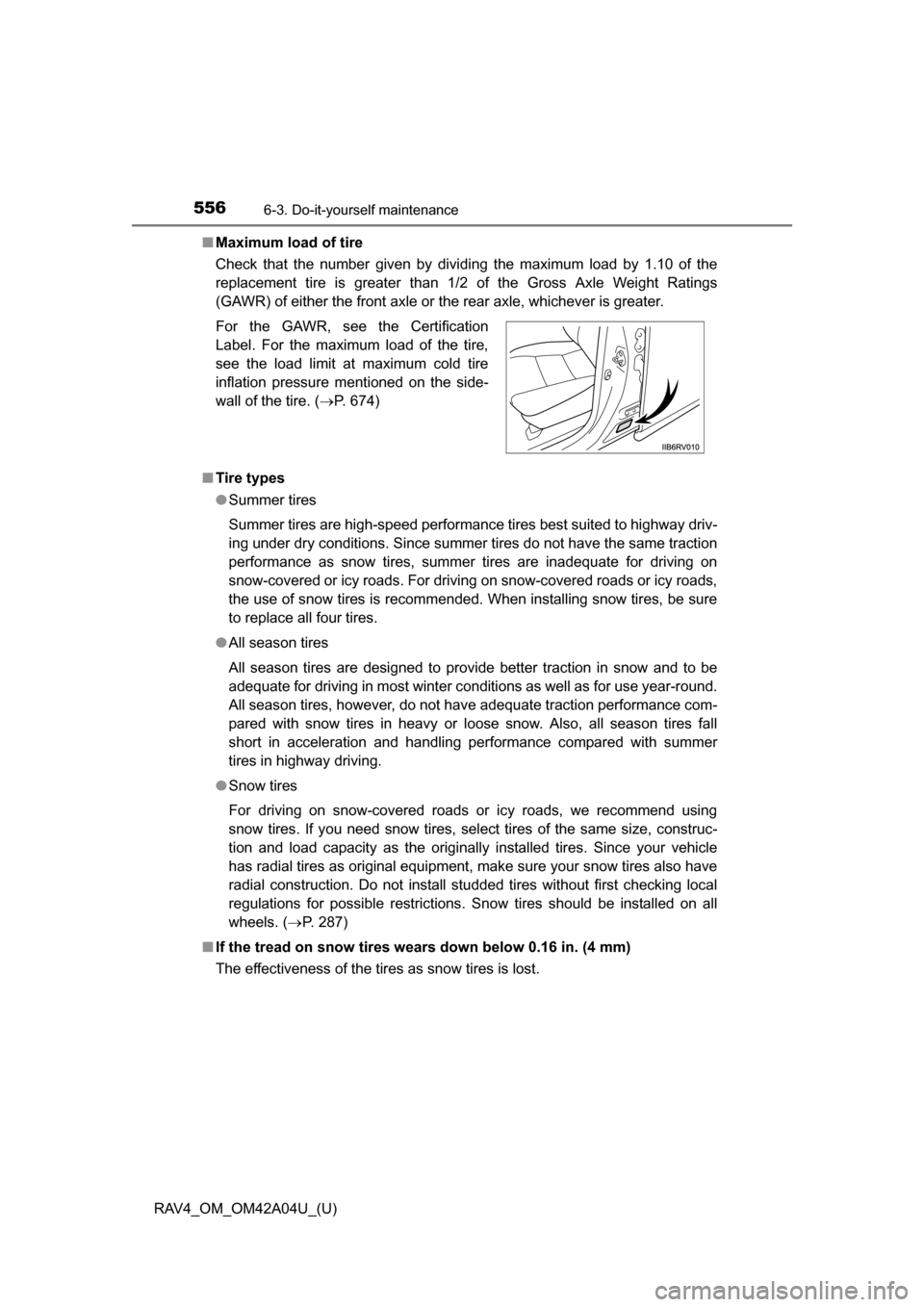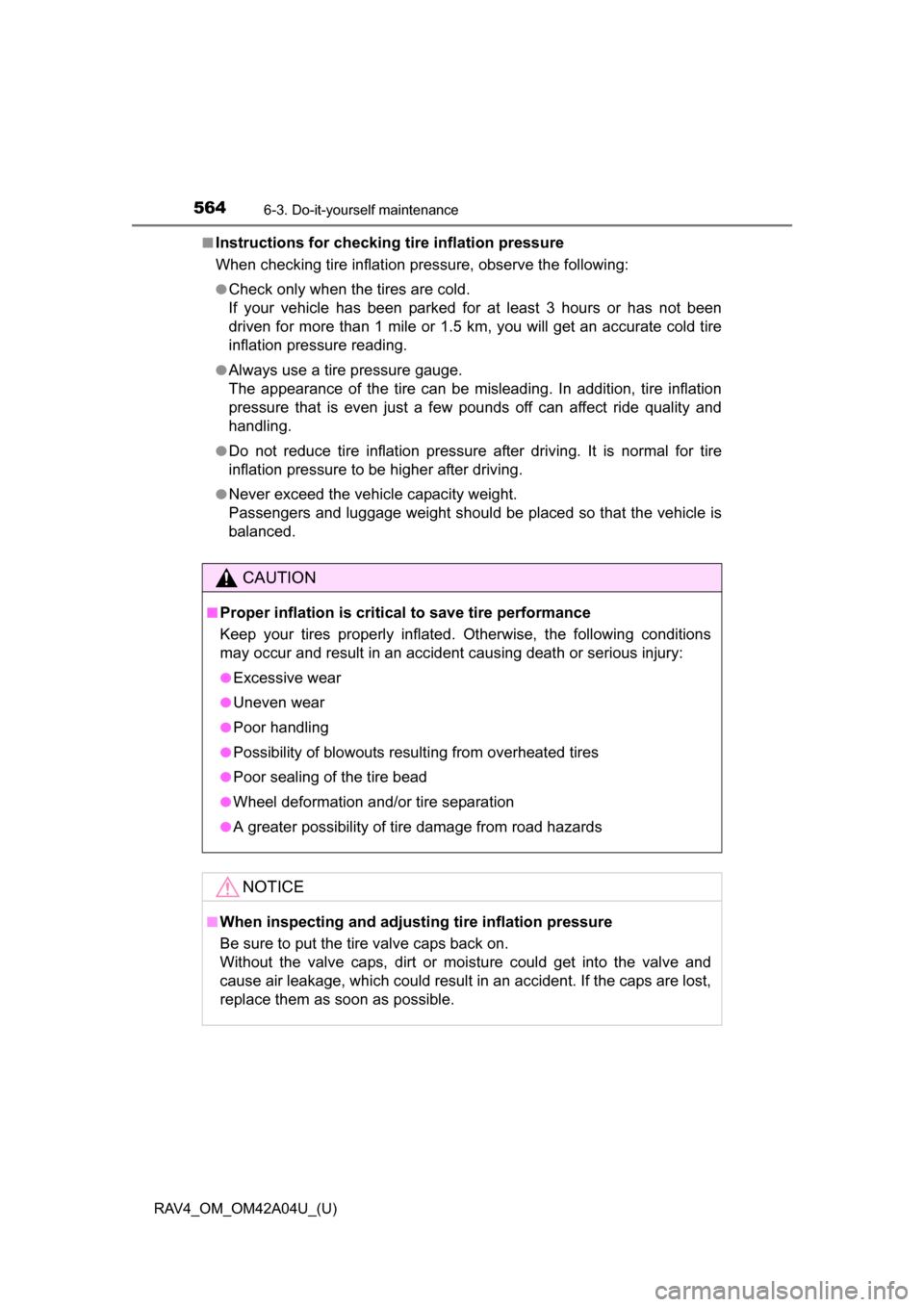Page 494 of 732
494
RAV4_OM_OM42A04U_(U)
5-5. Using the storage features
Luggage compar tment features
Raise the hooks to use.
The cargo hooks are provided for
securing loose items.
Cargo hooks
CAUTION
■When the cargo hooks are not in use
To avoid injury, always return the cargo hooks to their stowed positions.
Grocery bag hooks
NOTICE
■Grocery bag hook weight capacity
Do not hang any object heavier than 8.8 lb. (4 kg) on the grocery bag hooks.
Page 502 of 732
502
RAV4_OM_OM42A04U_(U)
5-5. Using the storage features
CAUTION
■When installing/stowing the rear cargo net
Make sure that the rear cargo net is securely installed/stowed. Failure to do
so may result in serious injury in the event of sudden braking or a collision.
■ Caution for the rear cargo net
●To prevent cargo and luggage from sliding forward during braking, do not
place anything on the net higher than the rear seatbacks. Otherwise, such
items may be thrown about and possibly injure people in the vehicle during
sudden braking or an accident.
● Do not allow children to climb on the cargo net. Climbing on the cargo net
could result in damage to the cargo net, possibly causing death or serious
injury to the child.
NOTICE
■Rear cargo net weight capacity
Do not place anything heavier than 22.1 lb. (10 kg) on the cargo net.
Page 507 of 732
RAV4_OM_OM42A04U_(U)
5075-6. Other interior features
5
Interior features
CAUTION
■Burns
●Use caution when seating the following persons in a seat with the seat
heater on to avoid the possibility of burns:
• Babies, small children, the elderly, the sick and the physically chal-
lenged
• Persons with sensitive skin
• Persons who are fatigued
• Persons who have taken alcohol or drugs that induce sleep (sleeping drugs, cold remedies, etc.)
● Do not cover the seat with anything when using the seat heater.
Using the seat heater with a blanket or cushion increases the temperature
of the seat and may lead to overheating.
● Do not use the seat heater more than necessary. Doing so may cause
minor burns or overheating.
NOTICE
■To prevent seat heater damage
Do not put unevenly weighted objects on the seat and do not stick sharp
objects (needles, nails, etc.) into the seat.
■ To prevent battery discharge
Turn the seat heaters off when the engine is not running.
Page 556 of 732

556
RAV4_OM_OM42A04U_(U)
6-3. Do-it-yourself maintenance
■Maximum load of tire
Check that the number given by dividing the maximum load by 1.10 of the
replacement tire is greater than 1/2 of the Gross Axle Weight Ratings
(GAWR) of either the front axle or the rear axle, whichever is greater.
■ Tire types
●Summer tires
Summer tires are high-speed performance tires best suited to highway driv-
ing under dry conditions. Since summer tires do not have the same traction
performance as snow tires, summer tires are inadequate for driving on
snow-covered or icy roads. For driving on snow-covered roads or icy roads,
the use of snow tires is recommended. When installing snow tires, be sure
to replace all four tires.
● All season tires
All season tires are designed to provide better traction in snow and to be
adequate for driving in most winter conditions as well as for use year-round.
All season tires, however, do not have adequate traction performance com-
pared with snow tires in heavy or loose snow. Also, all season tires fall
short in acceleration and handling performance compared with summer
tires in highway driving.
● Snow tires
For driving on snow-covered roads or icy roads, we recommend using
snow tires. If you need snow tires, select tires of the same size, construc-
tion and load capacity as the originally installed tires. Since your vehicle
has radial tires as original equipment, make sure your snow tires also have
radial construction. Do not install studded tires without first checking local
regulations for possible restrictions. Snow tires should be installed on all
wheels. ( P. 287)
■ If the tread on snow tires wears down below 0.16 in. (4 mm)
The effectiveness of the tires as snow tires is lost. For the GAWR, see the Certification
Label. For the maximum load of the tire,
see the load limit at maximum cold tire
inflation pressure mentioned on the side-
wall of the tire. ( P. 674)
Page 564 of 732

564
RAV4_OM_OM42A04U_(U)
6-3. Do-it-yourself maintenance
■Instructions for checking tire inflation pressure
When checking tire inflation pressure, observe the following:
●Check only when the tires are cold.
If your vehicle has been parked for at least 3 hours or has not been
driven for more than 1 mile or 1.5 km, you will get an accurate cold tire
inflation pressure reading.
●Always use a tire pressure gauge.
The appearance of the tire can be misleading. In addition, tire inflation
pressure that is even just a few p ounds off can affect ride quality and
handling.
●Do not reduce tire inflation pressure after driving. It is normal for tire
inflation pressure to be higher after driving.
●Never exceed the vehicle capacity weight.
Passengers and luggage weight should be placed so that the vehicle is
balanced.
CAUTION
■Proper inflation is critical to save tire performance
Keep your tires properly inflated . Otherwise, the following conditions
may occur and result in an accident causing death or serious injury:
●Excessive wear
●Uneven wear
●Poor handling
●Possibility of blowouts result ing from overheated tires
●Poor sealing of the tire bead
●Wheel deformation and/or tire separation
●A greater possibility of tire damage from road hazards
NOTICE
■When inspecting and adjusting tire inflation pressure
Be sure to put the tire valve caps back on.
Without the valve caps, dirt or moisture could get into the valve and
cause air leakage, which could result in an accident. If the caps are lost,
replace them as soon as possible.
Page 565 of 732

565
RAV4_OM_OM42A04U_(U)
6-3. Do-it-yourself maintenance
6
Maintenance and care
Wheels
When replacing wheels, care should be taken to ensure that they are
equivalent to those removed in load capacity, diameter, rim width and
inset
*.
Replacement wheels are available at your Toyota dealer.
*: Conventionally referred to as “offset”.
Toyota does not recommend using the following:
● Wheels of different sizes or types
● Used wheels
● Bent wheels that have been straightened
● Use only Toyota wheel nuts and wrenches designed for use with
your aluminum wheels.
● When rotating, repairing or changi ng your tires, check that the
wheel nuts are still tight after driving 1000 miles (1600 km).
● Be careful not to damage the aluminum wheels when using tire
chains.
● Use only Toyota genuine balance weights or equivalent and a plas-
tic or rubber hammer when balancing your wheels.
If a wheel is bent, cracked or heavily corroded, it should be
replaced. Otherwise, the tire may separate from the wheel or
cause a loss of handling control.
Wheel selection
Aluminum wheel precautions
Page 660 of 732
660
RAV4_OM_OM42A04U_(U)
8-1. Specifications
Maintenance data (fuel, oil level, etc.)
*: Unladen vehicle
Dimensions and weights
Overall length179.9 in. (4570 mm)
Overall width72.6 in. (1845 mm)
Overall height*
Without the roof
luggage carrier65.4 in. (1660 mm)
With the roof lug-
gage carrier67.1 in. (1705 mm)
Wheelbase104.7 in. (2660 mm)
Front and rear
tread17-inch tires61.8 in. (1570 mm)
18-inch tires61.4 in. (1560 mm)
Vehicle capacity weight
(Occupants + luggage)900 lb. (410 kg)
Trailer Weight Rating
(Trailer weight + cargo weight)1500 lb. (680 kg)
Page 681 of 732

RAV4_OM_OM42A04U_(U)
6818-1. Specifications
8
Vehicle specifications
Glossary of tire terminology
Tire related termMeaning
Cold tire inflation pres-
sure
Tire pressure when the vehicle has been
parked for three hours or more, or has not
been driven more than 1 mile or 1.5 km under
that condition
Maximum inflation
pressureThe maximum cold inflated pressure to which
a tire may be inflated, shown on the sidewall
of the tire
Recommended infla-
tion pressureCold tire inflation pressure recommended by a
manufacturer
Accessory weight
The combined weight (in excess of those stan-
dard items which may be replaced) of hybrid
transmission, power steering, power brakes,
power windows, power seats, radio and
heater, to the extent t hat these items are avail-
able as factory-installed equipment (whether
installed or not)
Curb weight
The weight of a motor vehicle with standard
equipment, including the maximum capacity of
fuel, oil and coolant, and if so equipped, air
conditioning and additional weight optional
engine
Maximum loaded vehi-
cle weight
The sum of:
(a) Curb weight
(b) Accessory weight
(c) Vehicle capacity weight
(d) Production options weight
Normal occupant
weight150 lb. (68 kg) times the number of occupants
specified in the second column of Table 1
*
that follows
Occupant distributionDistribution of occupants in a vehicle as speci-
fied in the third column of Table 1
* below